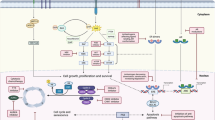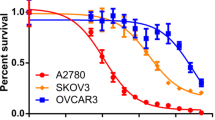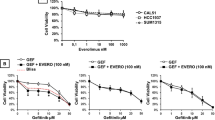Abstract
Pamidronate (PAM) and zoledronic acid (ZOL) are aminobisphosphonates (BPs) able to affect the isoprenylation of intracellular small G proteins. We have investigated the antitumor activity of BPs and R115777 farnesyl transferase inhibitor (FTI) against epidermoid cancer cells. In human epidermoid head and neck KB and lung H1355 cancer cells, 48 h exposure to PAM and ZOL induced growth inhibition (IC50 25 and 10 μ M, respectively) and apoptosis and abolished the proliferative and antiapoptotic stimuli induced by epidermal growth factor (EGF). In these experimental conditions, ZOL induced apoptosis through the activation of caspase 3 and a clear fragmentation of PARP was also demonstrated. A strong decrease of basal ras activity and an antagonism on its stimulation by EGF was recorded in the tumor cells exposed to BPs. These effects were paralleled by impaired activation of the survival enzymes extracellular signal regulated kinase 1 and 2 (Erk-1/2) and Akt that were not restored by EGF. Conversely, farnesol induced a recovery of ras activity and antagonized the proapoptotic effects induced by BPs. The combined treatment with BPs and R115777 resulted in a strong synergism both in growth inhibition and apoptosis in KB and H1355 cells. The synergistic activity between the drugs allowed BPs to produce tumor cell growth inhibition and apoptosis at in vivo achievable concentrations (0.1 μmolar for both drugs). Moreover, the combination was highly effective in the inhibition of ras, Erk and Akt activity, while farnesol again antagonized these effects. In conclusion, the combination of BPs and FTI leads to enhanced antitumor activity at clinically achievable drug concentrations that resides in the inhibition of farnesylation-dependent survival pathways and warrants further studies for clinical translation.
This is a preview of subscription content, access via your institution
Access options
Subscribe to this journal
Receive 50 print issues and online access
$259.00 per year
only $5.18 per issue
Buy this article
- Purchase on Springer Link
- Instant access to full article PDF
Prices may be subject to local taxes which are calculated during checkout








Similar content being viewed by others
References
Aikawa R, Komuro I, Yamazaki T, Zou Y, Kudoh S, Tanaka M, Shiojima I, Hiroi Y and Yazaki Y . (1997). J. Clin. Invest., 100, 1813–1821.
Ali SM, Esteva FJ, Hortobagyi G, Harvey H, Seaman J, Knight R, Costa L and Lipton A . (2001). J. Clin. Oncol., 19, 3434–3437.
Alvarez-Tejado M, Naranjo-Suarez S, Jimenez C, Carrera AC, Landazuri MO and del Peso L . (2001). J. Biol. Chem., 22, 22368–22374.
Aparicio A, Gardner A, Tu Y, Savage A, Berenson J and Lichtenstein A . (1998). Leukemia, 12, 220–229.
Averbuch SD . (1993). Cancer, 72, 3443–3452.
Aznar S and Lacal JC . (2001). Cancer Lett., 165, 1–10.
Benford HL, Frith JC, Auriola S, Monkkonen J and Rogers MJ . (1999). Mol. Pharmacol., 56, 131–140.
Boissier S, Ferreras M, Peyruchaud O, Magnetto S, Ebetino FH, Colombel M, Delmas P, Delaissè JM and Clézardin P . (2000). Cancer Res., 60, 2949–2954.
Cascinu S, Graziano F, Alessandroni P, Ligi M, Del Ferro E, Rossi D, Ficarelli R and Catalano G . (1998). Support. Care Cancer, 6, 139–143.
Chou TC, Motzer RJ, Tong Y and Bosl GJ . (1994). J. Natl. Cancer Inst., 86, 1517–1524.
Chou TC and Talalay P . (1984). Adv. Enzyme Regul., 22, 27–55.
Coleman RE, Woll PJ, Miles M, Scrivener W and Rubens RD . (1988). Br. J. Cancer, 58, 621–625.
DeSolms SJ, Ciccarone TM, MacTough SC, Shaw AW, Buser CA, Ellis-Hutchings M, Fernandes C, Hamilton KA, Huber HE, Kohl NE, Lobell RB, Robinson RG, Tsou NN, Walsh ES, Graham SL, Beese LS and Taylor JS . (2003). J. Med. Chem., 46, 2973–2984.
End DW . (1999). Exp. New Drugs, 17, 241–258.
End DW, Smets G, Todd AV, Applegate TL, Fuery CJ, Angibaud P, Venet M, Sanz G, Poignet H, Kelland LR, Smith V, Valenti M, Patterson L, Clarke PA, Detre S, End D, Howes PA, Howes AJ, Dowsett M, Workman P and Johnston SRD . (2001). Clin. Cancer Res., 7, 3544–3550.
Fiordalisi JJ, Johnson II RL, Weinbaum CA, Sakabe K, Casey PJ and Cox AD . (2003). J. Biol. Chem., 278, 41718–41727.
Fleisch H . (1991). Drugs, 42, 919–924.
Garrington TP and Johnson GL . (1999). Curr. Opin. Cell. Biol., 11, 211–218.
Haluska P, Dy GK and Adjei AA . (2002). Eur. J. Cancer, 38, 1685–1700.
Hancock JF, Magee AI, Childs JE and Marshall CJ . (1989). Cell, 57, 1167–1177.
Hilger RA, Scheulen ME and Strumberg D . (2002). Onkologie, 25, 511–518.
Hughes DE, Wright KR, Uy HL, Sasaki A, Yoneda T, Roodman GD, Mundy GR and Boyce BF . (1995). J. Bone Miner. Res., 10, 1478–1487.
Johnston SR . (2001). Lancet Oncol., 2, 18–26.
Kelland LR, Smith V, Valenti M, Patterson L, Clarke PA, Detre S, End D, Howes AJ, Dowsett M, Workman P and Johnston SRD . (2001). Clin. Cancer Res., 7, 3544–3550.
Kuo ML, Chuang SE, Lin MT and Yang SY . (2001). Oncogene, 20, 677–685.
Lebowitz PF, Casey PJ, Prendergast GC and Thissen JA . (1997). J. Biol. Chem., 272, 15591–15594.
Lebowitz PF and Prendergast GC . (1998). Oncogene, 45, 1439–1445.
Lee MV, Fong EM, Singer FR and Guenette RS . (2001). Cancer Res., 61, 2602–2608.
Lipton A, Glover D, Harvey H, Grabelsky S, Zelenakas K, Macerata R and Seaman J . (1994). Ann. Oncol., 5, s31–s35.
Liu B, Fang M, Lu Y, Mendelsohn J and Fan Z . (2001). Oncogene, 20, 1913–1922.
Luckman SP, Hughes DE, Coxon FP, Russell RG and Rogers MJ . (1998). J. Bone Miner. Res., 13, 581–589.
Mitsui H, Takuwa N, Maruyama T, Maekawa H, Hirayama M, Sawatari T, Hashimoto N, Takuwa Y and Kimura S . (2001). Int. J. Cancer, 92, 55–62.
Morton AB, Cantrill JA, Pillai GV, McMahon A, Anderson DC and Howell A . (1988). Br. Med. J., 297, 772–773.
Peng H, Wen TC, Tanaka J, Maeda N, Matsuda S, Desaki J, Sudo S, Zhang B and Sakanaka M . (1998). J. Cereb. Blood Flow Metab., 18, 349–360.
Porter AC and Vaillancourt RR . (1998). Oncogene, 17, 1343–1352.
Rogers MJ, Chilton KM, Coxon FP, Lawry J, Smith MO, Suri S and Russell RG . (1996). J. Bone Miner. Res., 11, 1482–1491.
Schafer WR and Rine J . (1992). Annu. Rev. Genet., 26, 209–237.
Sebti SM and Hamilton AD . (2000). Exp. Opin. Invest. Drugs, 9, 2767–2782.
Selleri C, Maciejewski JP, Montuori N, Ricci P, Visconte V, Serio B, Luciano L and Rotoli B . (2003). Blood, 102, 1490–1498.
Senaratne SG, Pirianov G, Mansi JL, Arnett TR and Colston KW . (2000). Br. J. Cancer, 82, 1459–1468.
Shipman CM, Rogers MJ, Apperley JF, Russell RG and Croucher PI . (1997). Br. J. Haematol., 98, 665–672.
Sibilia M, Fleischmann A, Behrens A, Stingl L, Carroll J, Watt FM, Schlessinger J and Wagner EF . (2000). Cell, 102, 211–220.
Smalley KSM and Eisen TG . (2002). Int. J. Cancer, 98, 514–518.
Stoll SW, Benedict M, Mitra R, Hiniker A, Elder JT and Nunez G . (1998). Oncogene, 16, 1493–1499.
Tamanoi F, Kato-Stankiewicz J, Jiang C, Machado I and Thapar N J . (2001). Cell. Biochem., 37, 64–70.
Tassone P, Forciniti S, Galea E, Morrone G, Turco MC, Martinelli V, Tagliaferri P and Venuta S . (2000). Leukemia, 14, 841–844.
Tassone P, Tagliaferri P, Viscomi C, Palmieri C, Caraglia M, D'Alessandro A, Galea E, Goel A, Abbruzzese A, Boland CR and Venuta S . (2003). Br. J. Cancer, 88, 1971–1978.
Tilly JL, Billig H, Kowalski KI and Hsueh AJ . (1992). Mol. Endocrinol., 6, 1942–1950.
Twiss IM, Pas O, Ramp-Koopmanschap W, Den Hartigh J and Vermeij P . (1999). J. Bone Miner. Res., 14, 784–791.
Van Beek E, Pieterman E, Cohen L, Lowik C and Papapoulos C . (1999a). Biochem. Biophys. Res. Commun., 255, 491–494.
Van Beek E, Pieterman E, Cohen L, Lowik C and Papapoulos S . (1999b). Biochem. Biophys. Res. Commun., 264, 108–111.
Vitale G, Fonderico F, Martignetti A, Caraglia M, Ciccarelli A, Nuzzo V, Abbruzzese A and Lupoli G . (2001). Br. J. Cancer, 84, 1586–1590.
von Gise A, Lorenz P, Wellbrock C, Hemmings B, Berberich-Siebelt F, Rapp UR and Troppmair . (2001). J. Mol. Cell. Biol., 21, 2324–2336.
Widmann C, Gibson S, Jarpe MB and Johnson GL . (1999). Physiol. Rev., 79, 143–180.
Wood J, Bonjean K, Ruetz S, Bellahcène A, Devy L, Foidart JM, Castronovo V and Green JR . (2002). J. Pharm. Exp. Therap., 302, 1055–1061.
Yan CYI and Greene LA . (1998). J. Neurosci., 18, 4042–4049.
Zhou H, Li X-M, Meinkoth J and Pittman RN . (2000). J. Cell Biol., 151, 483–494.
Acknowledgements
This work was supported by grants from Italian Minister for Research (PRIN2003) and Italian Minister of Health (FSN 2003).
Author information
Authors and Affiliations
Corresponding authors
Rights and permissions
About this article
Cite this article
Caraglia, M., D'Alessandro, A., Marra, M. et al. The farnesyl transferase inhibitor R115777 (Zarnestra®) synergistically enhances growth inhibition and apoptosis induced on epidermoid cancer cells by Zoledronic acid (Zometa®) and Pamidronate. Oncogene 23, 6900–6913 (2004). https://doi.org/10.1038/sj.onc.1207814
Received:
Revised:
Accepted:
Published:
Issue Date:
DOI: https://doi.org/10.1038/sj.onc.1207814
Keywords
This article is cited by
-
Zoledronic acid-loaded lipidic nanoparticles enhance apoptosis and attenuate invasiveness by inhibiting epithelial to mesenchymal transition (EMT) in HepG2 cancer cells
Naunyn-Schmiedeberg's Archives of Pharmacology (2021)
-
Various pathways of zoledronic acid against osteoclasts and bone cancer metastasis: a brief review
BMC Cancer (2020)
-
Pamidronate decreases bilirubin-impaired cell death and improves dentinogenic dysfunction of stem cells from human deciduous teeth
Stem Cell Research & Therapy (2018)
-
Combination of zoledronic acid and serine/threonine phosphatase inhibitors induces synergistic cytotoxicity and apoptosis in human breast cancer cells via inhibition of PI3K/Akt pathway
Tumor Biology (2016)
-
Significance of KRAS/PAK1/Crk pathway in non-small cell lung cancer oncogenesis
BMC Cancer (2015)



